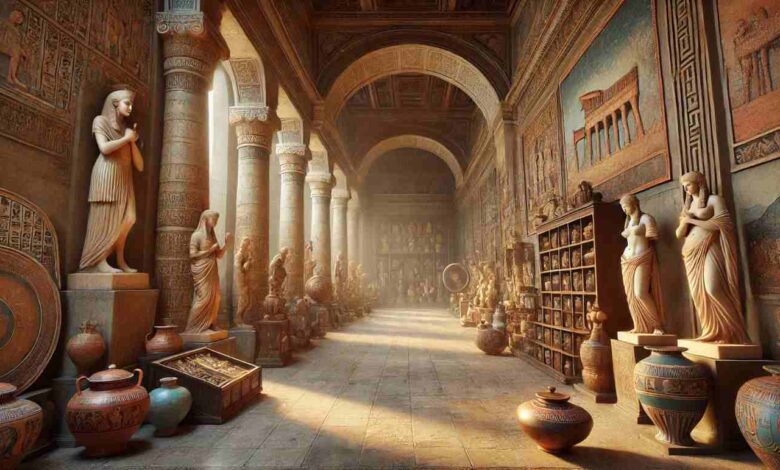Ancient Artz: Revealing the Untold Stories and Facts

Ancient art, often referred to as “Ancient Artz,” offers a fascinating window into the past, providing a glimpse into the cultures, beliefs, and everyday lives of early civilizations. From the enigmatic cave paintings of prehistoric times to the grandeur of Greek and Roman sculptures, ancient art is a testament to human creativity and expression throughout history. This article will delve into the various forms of Ancient Artz, its significance, and the lasting impact it has had on modern culture.
The Origins of Artistic Expression: Prehistoric Art
The art of Ancient Artz starts with the very early examples of human creativity, such as prehistoric cave paintings. Some of those created pieces date back to the period that is known as the Upper Paleolithic, which is estimated to be 40,000–10,000 BCE. The most famous of these early examples are the Lascaux caves in France, and they are rich in images of horses, bison, and deer. All these paintings are believed to be for some ritual or symbolic purposes, illustrating the close bond between early humans and nature and probably their spiritual practices.
Mesopotamian Art: The Cradle of Civilization
It developed alongside human societies. Art was important in the religious and political lives of ancient Mesopotamia, also known as the “Cradle of Civilization.” Sumerians, Akkadians, Babylonians, and Assyrians made sculptural works, cylinder seals, and bas-reliefs very detailed. One of the most famous pieces from this period is the Stele of Hammurabi, a basalt monument inscribed with one of the earliest known legal codes, in which art becomes united with governance.
The blue-glazed bricks and the reliefs of lions that decorated the Ishtar Gate of Babylon were symbolic of the grandeur of the Babylonian architecture in ceremonial importance. Mesopotamian art represents religious and political ideals, but in the actual social structure and everyday life of these earliest civilizations, something very tangible is revealed.
Egyptian Art: The Eternal Symbols of the Nile
The work of ancient Egyptian art is some of the most recognizable and iconic around the world due to its strict conventions and symbolism. This art was deeply related to religion and the afterlife: tomb paintings, statues, and hieroglyphs were designed for the honoring of deities and assurance of a safe journey of the deceased in the afterlife. The pyramids of Giza and the treasures found in the tomb of Tutankhamun provide an excellent example of the architectural and artistic abilities of the Egyptians.
Egyptian art was not a mere decorative entity but an instrument in maintaining cosmic order and divine favor. One always notices the continuous style in Egyptian art, where the figures are often represented in rigid, frontal poses. It is meant to reflect the stability and continuity of Egyptian society for thousands of years.
Greek and Roman Art: Foundations of Western Aesthetics
Greek art is celebrated for the pursuit of idealism and naturalism; it was especially seen in their sculptures. The Greeks revolutionized the representation of art, enforcing proportion, balance, and anatomic correctness. All these can be witnessed from Parthenon, in which the architecture and sculptural decorations combine to fully and dramatically utilize the results of the artistic accomplishments of ancient Greece. Most of the Greek pottery, frescoes, and sculptures bear different mythological and daily-life scenes which very often underline the story-telling and cultural feature of ancient Greece.
Roman art, heavily influenced by Greek precedents, focused on realism and the glorification of the empire. Of course, lifelike Roman portraiture is interesting because it gives one some insight into personalities and the social pecking order in Roman times. The most famous Roman works in art are the Colosseum and the aqueducts, which show advanced engineering and aesthetic considerations in the edifice to its majesty. The use of concrete, creating immense public spaces, points out the Romans’ commitment to grandeur and utility.
The Cultural Significance of Ancient Artz
“Ancient Artz” was art that supported the making of culture and identity for ancient civilizations. The main purpose behind art in ancient Egypt was to reinforce the divine right of pharaohs to rule, and the grandeur of Egyptian art was supposed to show off the power and authority of the pharaohs. Similarly, in ancient Greece, art was used to promote civic pride and unity, reflected in the size of temples and public buildings by the Greeks because of the belief in the importance of the polis, the city-state.
In ancient Mesopotamia, art was a means of communicating religious and political messages. The famous Code of Hammurabi, for example, was a legal document chiseled in big stone stele, ornamented with a relief, and showed the king receiving the laws from the god Shamash. Thus, the way in which art was used to transfer important cultural values and beliefs reflected the complex social and political fabric of the ancient world.
The Enduring Legacy of Ancient Artz
The influence of “Ancient Artz” can even be traced into contemporary arts and culture. Techniques, styles, and themes developed by ancient men have been passed on through the centuries and remain influential as they inspire modern-day artists. For example, the classical style of ancient Greece is continued through several centuries in proportion, balance, and harmony. The Renaissance is the age of revived interest in the art of antiquity; the greatest artists of the time drew inspiration from the ancient Greek and Roman works.
What is more, the art from ancient Egypt was never missed out in sparking off interest among other artists and designers. The iconic imagery of pyramids, sphinxes, and pharaohs has been used across everything from fashion to film, while influence from Egyptian art can be seen in the early 20th-century Art Deco movement.
The Bottom Line
“Ancient Artz” is not a study about artifacts from history, but a journey down into the heart of creativity and expression by the very first mankind. These masterpieces emanate deep affiliation to our past, bringing out values, beliefs, and artistic accomplishments of the ancient people. Through the series of time-fixed artistic creations, there is learning of what predecessors’ lives, beliefs, and accomplishments were. The preservation and study of ancient art preserve the legacy of these early creators and help them continue to inspire future generations. The power of creativity in humans is guaranteed, and the nature of artistic expression is timeless, as we keep learning from it and appreciating it more and more.




